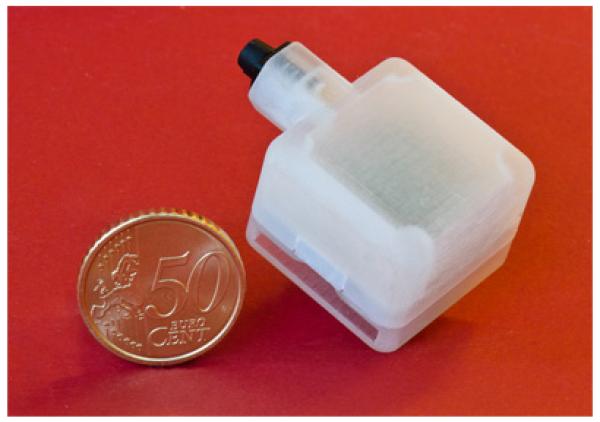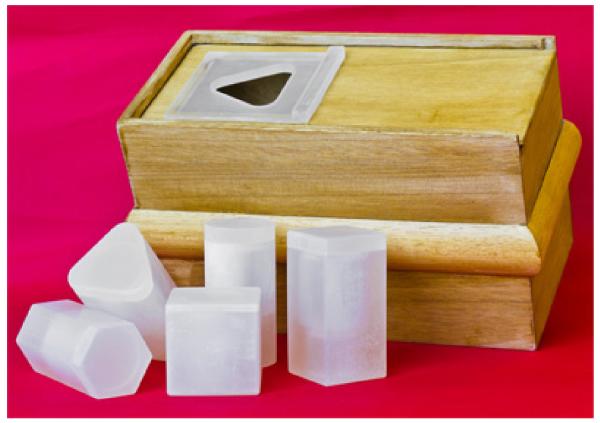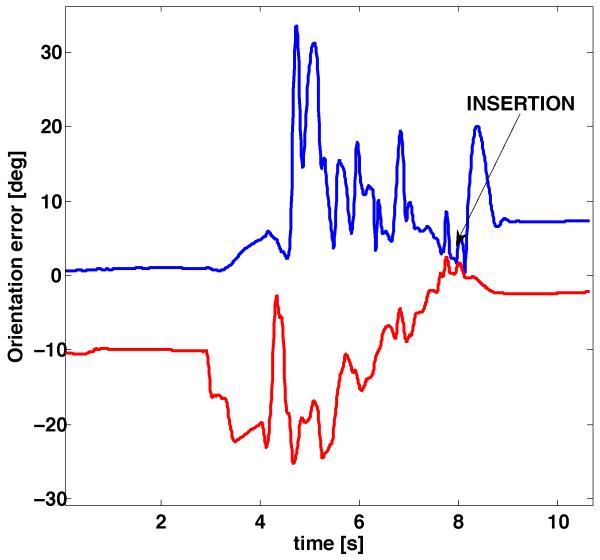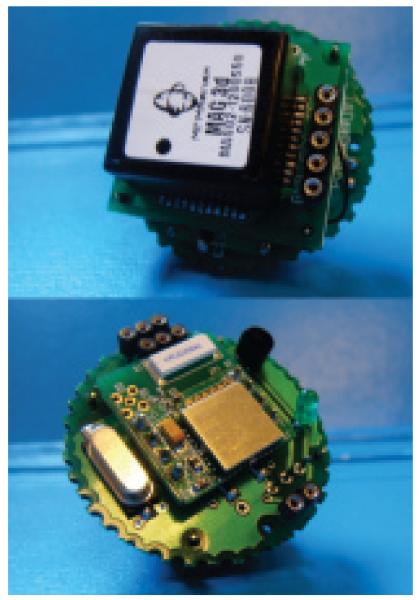Abstract
Motor impairments seems to play an important role in neurodevelopmental disorders such as autism spectrum disorders (ASD). Early detection of motor abnormalities during first years of life, may give important information regarding whether a child may receive a later diagnosis of Autism: for this reason an objective assessment of motor performance is crucial. While there are several technological solutions suitable to this end, they often require highly structured environments. In this work we propose the use of a magneto-inertial platform to study early motor performance between 12-36 months of age suitable to be used in non-structured environment.
I. INTRODUCTION
Although deficits in social communication are considered primary in autism spectrum disorders (ASD), recent evidence suggests that motor impairments also constitute a prominent component of the ASD behavioral profile. This is critical since progressive acquisition of motor skills provides infants with an increasingly diverse set of opportunities for acquiring, practicing and refining abilities prerequisite for growth in other domains, especially those of language and social interaction [1]. Motor skill delays and impairments may thus have cascading effects on development extending well beyond the motor domain.
Interest in the identification of behavioral markers of ASD in infancy [2] has recently led to a number of prospective, longitudinal studies of infants at heightened biological risk for ASD (High-Risk infants; HR). These infants, who have an older sibling already diagnosed with autism, are approximately 200 times more likely than those in the general population to receive an ASD diagnosis. [3]. While these studies have focused on a number of behavioral characteristics of HR infants, little attention has been devoted to the early development of motor skills, despite the primacy of motor development in infancy and the growing literature on motor concerns in ASD e.g. [4].
II. ASSESSING MOVEMENT
A. The technological approach
There are several technological solutions available to go beyond a qualitative analysis of infants motor behavior, such as stereophotogrammetric movement analysis systems, gaze-tracking devices, and force platforms. Studies of reaching/grasping tasks in children, for example, have typically been conducted by means of camera-based motion capture systems with passive markers [5]-[7]. Such an approach, besides being very expensive, requires a highly structured environment (i.e., laboratories), that can intimidate children.
Our main focus is developing technological platforms which meet the following main requirements:
non-obtrusive technology: the new devices will be designed with the goal of continuous monitoring without being distressful or obtrusive for children (e.g. instrumented toys and wearable sensors). This approach clearly sets constraints on the type of technology to be used; hence, their technical design will be guided by the key criteria of being small in size, lightweight, wireless, and portable.
minimally structured and ecological operating environments: given that current motion analysis tools (photogrammetric devices, force platforms, gaze trackers) are suitable only for controlled and highly structured environments, screening a large number of children for diagnostic is not feasible due to the high costs, limited availability, and poor transportability of equipment. The new devices will therefore be designed for application outside the laboratory.
Hence, we aim to develop cost-effective devices requiring minimally structured environments and designed to operate in ecological scenarios, ranging from fully unstructured home-like situations, where a caregiver guides the game along predefined play protocols and tasks, to more structured situations such as Neonatal Intensive Care Units (NICU).
We focus our attention on upper limb movements and in particular on the acquisition of fine manipulation and motor planning skills. As argued from [8] and [9], motor planning plays a crucial role in motor development of children, since from first year of life. These skills seems to be impaired in children with Autism [10].
B. Instrumented toys and wearable devises
Claxton and colleagues [8] have shown that reaching for an object in precision tasks has kinematical features which are different from reaching for the same object in a nonprecision tasks. These differences regards mainly accelerations. Moreover, several studies of sensory-motor performance, including those concerned with changes because of age, disease, or therapeutic intervention, often use measures based on jerk, the time derivative of acceleration, to quantify smoothness and coordination (see [11] for a review). As shown in [9], motor preplanning skills can be assessed by studying how infants fit objects of different cross sections into holes. In particular it is possible to measure two errors: the vertical error, i.e. how much the object is tilted with respect to gravity; and the horizontal error, i.e. the misalignment between the object and the hole. In the original protocol, these two errors were assessed at time of first contact of the object with the box by means of video coding. Among several variables that could be used, the ones reported above, related to acceleration and orientation error, can be easily recorded by means of magneto-inertial sensors. These sensors are ecological, non-obtrusive and can be easily embedded into objects. Even if this technology does not permit measurement of position and velocity, it can be effectively used for sourceless orientation estimation [12] from which it is possible a semi-automatic assessment of preplanning error in the shape-sorter protocol [13], [14] is possible. Moreover, if the spatial orientation is known, it is possible calculate linear acceleration due to the movement (i.e the acceleration subtracted of gravitational contribution), which may be used to measure kinematical variables during reaching. For this reason, we developed a magneto-inertial platform composed of three sensors: two wired magneto-inertial sensors (20mm × 20mm × 15mm, weight: 14 g) that can be worn by infants on their wrists, (see Fig. 2 Wrist Movement Sensor WMS), and a wireless bluetooth magneto inertial module (17.8mm × 17.8mm × 10.2mm weight: 30 g without battery) which is embedded into manipulated objects. The sensing core, common both to instrumented toy and wearable devices, is designed to sense 2g accelerations, 1200 deg/s angular rates, 1 Gauss magnetic fields, all within a 50 Hz bandwidth.
Fig. 2.
Wrist Movement Sensor
The sensors are coupled with a multi-channel, 12 bits AD converter (model MAX1238 from Maxim Inc.) which can retransmit converted data over a 4-wires I2C bus. For our application, we sample each of the 9 channels at 100 Samples/sec rate. These data are collected and rearranged in a specific message format by a microcontroller and then retransmitted via RS232 (wrist sensors) or bluetooth device (object sensor). Two 3.6V Li- Ion Rechargeable batteries (LIR3048 from Powerstream Inc.) are used in series to guarantee approximately an hour of autonomous operation. Data transmitted over the bluetooth or RS232 interface, are collected by a nearby PC, for later data analysis. This provide for the first time a net of both wearable and environmental magneto-inertial sensors embedded into objects that cab be used at the same time to assess the planning skills of children. With respect to previous studies, the proposed technology allows the study of children in their environment, reducing their stress and allowing the collection of additional important quantitative information e.g the trajectory of orientation error in the shape sorter protocol.
III. IN-FIELD USE
A. Experimental Procedure
The platform described above has been developed for use in a research project in which infants at low risk for development of autism are compared with High Risk infants. Children’s motor performance is assessed in three tasks: Ball in Tube, Tower Building, and Shape Sorter.
According to Claxton and colleagues [8], when infants reach for an object, kinematic measures of their approach movement are affected by what they intend to do after grasping it: they reached for the object faster if they were going to subsequently throw it as opposed to using it in a precision action. For this reason the first two tasks are divided in two parts: a Throw part (i.e. a non precision action) and a Fit part (i.e a precision action).
These tasks have been selected to be developmentally appropriate across 12-36 month age range. The child is seated at a child-sized wooden table across from the experimenter, wears a WMS on each wrist, and manipulates small objects containing the bluetooth sensing core. In order to have a fixed reference point for kinematic calculations, at the start of every trial, the child is encouraged to place their hands on the table at a specified starting location.
In the first task (Ball in the Tube), the child is asked to perform three trials in which she/he has to throw a small ball (5 cm in diameter) into a transparent plastic tub (30 cm × 13 cm × 2.7 cm). These are followed by three trials in which s/he is asked to insert the ball into a clear tube (5.5. cm. in diameter) open at both ends.
In the second task (Tower Building), the child is asked to place a block into a large open container (18 cm × 12 cm × 7 cm), for three trials. Subsequently s/he is asked to place 4 similar blocks (only the first of which is sensorized) on a target block to make a tower. Depending on the level of the child’s skill, towers can range in height from 2 to 5 blocks.
In the Shape Sorter task, the child is asked to insert a shape into a box (14cm ×11 cm ×11.5cm) with interchangeable lids. Each lid has an aperture corresponding to but only slightly larger (1 mm) than the cross-section of the shape to be inserted. Each object is presented six times: 3 times in initial vertical orientation and three in initial horizontal orientation. The shapes used for this protocol are: CIRcle, PARallelepiped, HEXagonal prism, and equilateral TRIangle (see Fig.3)
Fig. 3.
Shape sorter equipment.
B. Data analysis and Preliminary Results
The raw data from the sensors were fed, offline, into the attitude estimator [12] to derive a sequence of rotations Ri, one for each data packet. Since the orientation of the sensor at each time instant is known, it is possible to measure the linear acceleration i.e the acceleration due only to the child’s movements as:
| (1) |
where g0 represents only the gravitational acceleration, measured by the sensor at the beginning of the trial. Because all the orientation measurements refer to the initial orientation of the sensor, g0 corresponds to the gravitational acceleration in the base reference frame. Once the linear acceleration is known, it is possible to calculate the smoothness of movement as mean squared Jerk [16]:
| (2) |
The knowledge of the orientation matrices at each time-point also allows measurement of the orientation error in the shape sorter protocol. When a shape is presented to the child, it is always aligned with the hole and the initial frame of reference can be defined so that is the vertical axis aligned with gravity while and are the horizontal axes heading north and west, respectively. In this way, at all time, the vertical (|∊v|) and horizontal (|∊h|) angular misalignments can be determined directly from the projections of two moving axes (Rie3 and Rie1) onto the fixed axes (e1, e2, e3):
| (3) |
| (4) |
where the operation ensures that h is wrapped within ±π/N, where N is the number of possible insertions of the block.
In Fig. 4 an example of the orientation error measured during an insertion task is reported. Vertical error is plotted in blue; horizontal error is indicated in red.
Fig. 4.
Shape sorter protocol: vertical (blue) and horizontal (red) alignment errors
We tested the developed platform in a pilot experiment carried out at the day-care centre La Primavera del Campus, (Universitá Campus Bio-Medico, Rome, Italy), on a female child aged 18 months. She performed the all tasks but in the shape sorter protocol she was not able to insert the triangular block. For each trial we measured mean linear acceleration as defined in (1), peak acceleration and smoothness, see equation (2).
In the first two tasks, we compared motor indexes measured in the Throw part with the ones measured in the Fit part. For the third task, we measured preplanning error in terms of horizontal and vertical misalignment. In all tasks we distinguish two main phases: a reaching phase during which the child, starting from the initial position, reaches for the object that s/he has to manipulate; and a placing phase, during which the child moves the object to the target position. We measured kinematical parameter for both of these phases. Duration of each phase is measured by video recording of the experimental session. Timing information form video coding is used to segment kinematical data sequences.
Tables I and II report kinematic indexes measured for the Ball in the Tube and Tower Building tasks. The child we tested was able to stack four blocks in the Tower Building task. The alignment orientation of the first block was of 14.5°. In the first task, the impact of planning of a precise movement on the organization of reaching, is apparent. Both mean and peak wrist acceleration seems to be lower in the fitting relative to the throwing condition, such that when the childs task was to fit the ball into the tube, the reaching movement was slower than when he simply had to throw it into a plastic tub. In contrast, in the second task this is not evident. Tables III reports angular misalignment at the time of first contact measured in the Shape Sorter task. In the first columns blocks are listed in the order of presentation and their initial orientation: Vertical (V) or Horizontal (H). The last two lines have no data because child was not able to insert the triangular shape. According to [9] vertical error higher that 30° means a non developed planning ability: as stated in this work, 18 months old children understand the task (i.e. fitting object into holes) but are not able to pre-align them, this is confirmed by our preliminary results.
TABLE I.
Ball in the Tube: kinematical data
| Throw | Fit | |||
|---|---|---|---|---|
| Reach | Place | Reach | Place | |
| Mean acc [m/s2] | 4.67 | 3.9 | 1.23 | 4.8 |
|
| ||||
| Mean Peak acc [m/s2] | 12.89 | 9.63 | 4.52 | 9.23 |
|
| ||||
| Mean squared Jerk [m2/s6]*103 |
3.9353 | 1.3296 | 0.5994 | 1.5868 |
TABLE II.
Tower Building: kinematical data
| Throw | Stack | |||
|---|---|---|---|---|
| Reach | Place | Reach | Place | |
| Mean acc [m/s2] | 2.41 | 3.88 | 2.57 | 4.42 |
|
| ||||
| Mean Peak acc [m/s2] | 4.89 | 9.79 | 6.67 | 9.49 |
|
| ||||
| Mean squared Jerk [m2/s6]*103 |
0.4589 | 1.4525 | 1.0689 | 0.6458 |
TABLE III.
Shape Sorter: Preplanning orientation errors
| |∊v| [deg] |
|∊h| [deg] |
|
|---|---|---|
|
| ||
| CIR V | 39.3 | 0 |
| CIR H | 59.7 | 0 |
| PAR V | 37.1 | 12.2 |
| PAR H | 48.5 | 30.5 |
| HEX V | 39.2 | 9.3 |
| HEX H | 37.85 | 11.0 |
| TRI H | - | - |
| TRI V | - | - |
Our findings suggest that the results related to the first and the third tasks are coherent with previous studies [8], [9], but not for the second task. This should be due to the fact that in this pilot study we administered the tasks to only one subject.
IV. CONCLUSIONS
In this work a technological approach to study infant motor behavior has been presented and discussed. Although there are several technological solutions for infant motor behavior assessment, they often require well-controlled and highly structured environments (i.e., laboratories), that can intimidate children. For this reason we propose the use of a magneto inertial platform for ecological assessment of motor performance in infants aged between 12-36 months. We describe technology used, and propose a method for sensor data treatment. Finally we report a pilot study for in-field validation of the technology and the proposed methodology for data treatment. Future works on infant motor development will implement this proposed technique.
Fig. 1.
Electronic sensing core: (up sensing unit, down wireless trasmission board.
ACKNOWLEDGMENTS
This work was supported by the US National Institute of Health research grant, grant number: NIH R21 HD068584.
Contributor Information
Fabrizio Taffoni, Laboratory of Biomedical Robotics and Biomicrosystems, Università Campus Bio-Medico di Roma, via Álvaro del Portillo 21, 00128 Roma - Italy f.taffoni@unicampus.it.
Valentina Focaroli, Laboratory of developmental Neuroscience, Università Campus Bio-Medico di Roma, via Álvaro del Portillo 21, 00128 Roma - Italy v.focaroli@unicampus.it.
Domenico Formica, Laboratory of Biomedical Robotics and Biomicrosystems, Università Campus Bio-Medico di Roma, via Álvaro del Portillo 21, 00128 Roma - Italy.
Eugenio Gugliemelli, Laboratory of Biomedical Robotics and Biomicrosystems, Università Campus Bio-Medico di Roma, via Álvaro del Portillo 21, 00128 Roma - Italy e.guglielmelli@unicampus.it.
Flavio Keller, Laboratory of developmental Neuroscience, Università Campus Bio-Medico di Roma, via Álvaro del Portillo 21, 00128 Roma - Italy f.keller@unicampus.it.
Jana M. Iverson, Department of Psychology, University of Pittsburgh, Pittsburgh, PA 15260 - USA jiverson@pitt.edu
References
- [1].Iverson JM. Developing language in a developing body: The relationship between motor development and language development. Journal of Child Language. 2010;37:229–261. doi: 10.1017/S0305000909990432. [DOI] [PMC free article] [PubMed] [Google Scholar]
- [2].Zwaigenbaum L, Thurm A, Stone W, Baranek G, Bryson S, Iverson JM, Kau A, Klin A, Landa R, Lord C, Rogers S, Sigman M. Studying the emergence of Autism Spectrum Disorders in highrisk infants: Methodological and practical issues. Journal of Autism and Developmental Disorders. 2007;37:466–480. doi: 10.1007/s10803-006-0179-x. [DOI] [PubMed] [Google Scholar]
- [3].Ozonoff S, Young GS, Carter A, Messinger D, Yirmiya N, Zwaigenbaum L, Bryson S, Carver LJ, Constantino J, Dobkins K, Hutman T, Iverson JM, Landa R, Rogers SJ, Sigman M, Stone WL. Recurrence risk in younger siblings of children with Autism Spectrum Disorders: A BSRC study. Pediatrics. 2011;128:488–495. doi: 10.1542/peds.2010-2825. [DOI] [PMC free article] [PubMed] [Google Scholar]
- [4].Fournier KA, Hass CJ, Naik SK, Lodha N, Cauraugh JH. Motor coordination in Autism Spectrum Disorders: A synthesis and meta-analysis. Journal of Autism and Developmental Disorders. 2010;40:1227–1240. doi: 10.1007/s10803-010-0981-3. [DOI] [PubMed] [Google Scholar]
- [5].von Hofsten C, Ronquist L. The Structuring of Neonatal Arm Movements. Child Developments. 1993;64:1046–1057. [PubMed] [Google Scholar]
- [6].Bhat AN, Galloway JC. Toy-oriented changes during early harm movements: Hand Kinematics. Infant Behaviour and Development. 2006;29:358–372. doi: 10.1016/j.infbeh.2006.01.005. [DOI] [PubMed] [Google Scholar]
- [7].Bhat AN, Heathcock JH, Galloway JC. Toy-oriented changes in hand and joint kinematics during the emergence of purposeful reaching. Infant Behaviour and Development. 2005;28:445–465. [Google Scholar]
- [8].Claxton LJ, Keen R, McCarty M. Evidence of motor planning in infant reaching behavior. Psychological Science. 2003;14:354–356. doi: 10.1111/1467-9280.24421. [DOI] [PubMed] [Google Scholar]
- [9].Ornkloo H, von Hofsten C. Fitting objects into holes: on the development of spatial cognition skills. Dev. Psychol. 2007;43:404–16. doi: 10.1037/0012-1649.43.2.404. [DOI] [PubMed] [Google Scholar]
- [10].Fabbri-Destro M, Cattaneo L, Boria S, Rizzolatti G. Planning actions in autism. Experimental Brain Research. 192:521–525. doi: 10.1007/s00221-008-1578-3. [DOI] [PubMed] [Google Scholar]
- [11].Hogan N, Sternad D. Sensitivity of Smoothness Measures to Movement Duration, Amplitude, and Arrests. Journal of Motor Behavior. 2009;41(6):529–534. doi: 10.3200/35-09-004-RC. [DOI] [PMC free article] [PubMed] [Google Scholar]
- [12].Campolo D, Schenato L, Pi LJ, Deng X, Guglielmelli E. Multimodal Sensor Fusion for Attitude Estimation of Micromechanical Flying Insects: a Geometric Approach; IEEE/RSJ International Conference on Intelligent Robots and Systems (IROS); 2008.pp. 3859–3864. [Google Scholar]
- [13].Campolo D, Taffoni F, Formica D, Schiavone G, Keller F, Guglielmelli E. Inertial-Magnetic Sensors for Assessing Spatial Cognition in Infants. IEEE Transaction on Biomedical Engineering. 2011;58:1499–1503. doi: 10.1109/TBME.2011.2105871. [DOI] [PubMed] [Google Scholar]
- [14].Campolo D, Taffoni F, Formica D, Iverson J, Sparaci L, Keller F, Guglielmelli E. Embedding Inertial-Magnetic Sensors in Everyday Objects: Assessing Spatial Cognition in Children. Journal of iIntegrative neuroscience. doi: 10.1142/S0219635212500070. in press. [DOI] [PMC free article] [PubMed] [Google Scholar]
- [15].Taffoni F, Campolo D, Delafield-Butt J, Keller F, Guglielmelli E. Design and assembling of a magneto-inertial wearable device for ecological behavioral analysis of infants; procs. of IEEE/RSJ International Conference on Intelligent Robots and Systems (IROS08); 2008.pp. 3832–383. [Google Scholar]
- [16].Wininger M, Kim NH, Craelius W. Spatial resolution of spontaneous accelerations in reaching tasks. Journal of Biomechanics. 2009;42:2934. doi: 10.1016/j.jbiomech.2008.10.015. [DOI] [PubMed] [Google Scholar]
- [17].Boley D, Maier R. A Parallel QR Algorithm for the Non-Symmetric Eigenvalue Algorithm; Third SIAM Conference on Applied Linear Algebra; Madison, WI. 1988.p. A20. [Google Scholar]






